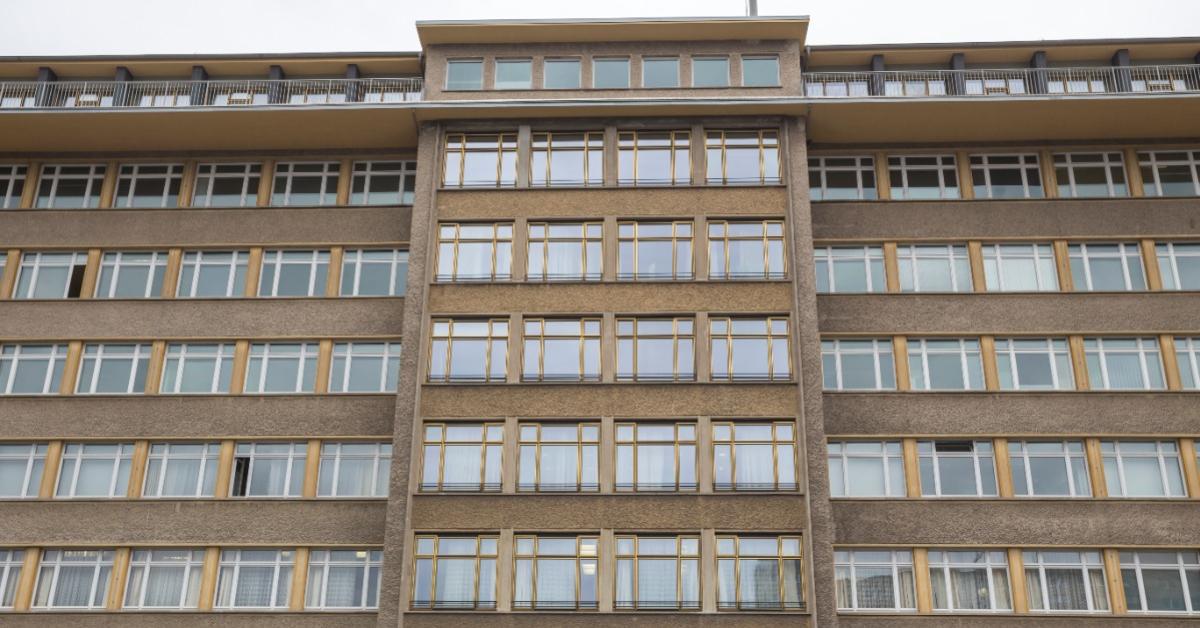
The state has a monopoly on violence. However, abusive repression harms government credibility and alienates public support in the long run. A more subtle and effective way to exercise power is to surveil the population and to prevent open manifestations of discontent.
This article analyzes the case of the of the German Democratic Republic’s (DDR) Ministry for State Security (MfS), also known as the Stasi. The thesis is that an effective surveillance regime makes the use of open violence less urgent because the population is nudged to discipline itself.
Shield and Sword of the Party
A shield and a sword form the symbol of the MfS, which is modeled on the emblem of the Cheka, the Soviet secret police. Discipline and loyalty to the Socialist Unity Party (SED) of the DDR were the core values of the Stasi. Members of the secret police saw themselves as first-class comrades who could make use of surveillance, propaganda, and psychological terror to secure the power of the communist regime.
One of the defining moments of the Stasi’s history was the general strike of June 17, 1953, which sparked widespread protests among the East German working class. The MfS failed to foresee the turmoil and had to repress it with the help of Soviet tanks and the imposition of martial law. Since the incident, the mission of the Stasi became to surveil society to prevent new open manifestations of dissent against the ruling of the SED.
Relentless Privacy Violations
The MfS developed one the most pervasive surveillance apparatuses in human history. In 1981, Erich Mielke, the head of the Stasi from 1957 to 1989, stated:
In its constant effort to clarify “who is who” the MfS—with its chekist forces, means and methods—has to identify people’s true political attitudes, their ways of thinking and behaving . . . to clarify means . . . providing an answer to who is an enemy; who is taking on a hostile and negative attitude; who is under the influence of hostile, negative and other forces and may become an enemy; who may succumb to enemy influences and allow himself to be exploited by the enemy; who has adopted a wavering position; and who can the party and the state depend on and be reliably supported by.
Many DDR citizens collaborated actively with the MfS. In 1989, near the end of the communist regime, the Stasi employed about ninety-one thousand people, or one out of every 180 residents. After 1968, the MfS relied heavily on unofficial collaborators, whose role was to report every major and minor sign of resentment and resistance against the SED. Unofficial collaborators were recruited after being carefully surveilled by the MfS to ensure total loyalty to the regime. They were well trained and used fake identification to infiltrate workplaces and neighborhoods. Among the 180,000 unofficial collaborators employed by the MfS in 1989, four thousand sneaked into opposition groups to spread false rumors and generate chaos. The case of Wolfgang Schnur is emblematic of the reach of the Stasi, as he was one of the most prominent lawyers who represented political dissidents. As an unofficial collaborator, however, he often exploited his position to betray his clients.
In the eighties, the Stasi performed between two hundred thousand and four hundred thousand security checks and investigations each year. The main targets were “political ideological diversion” and “political underground activity.” The Stasi’s eyes were focused on all social, cultural, and economic institutions of the DDR. Its employees were granted access to all the data they needed regarding citizens, including tax assessments, bank accounts, and health files. The Stasi deployed all kinds of mass surveillance techniques, such as telephone wiretaps, acoustic room surveillance, and postal espionage; they even collected body odor samples, which were used to train sniffer dogs.
Information about SED enemies could be used by the Stasi for psychological warfare. MfS undercover agents often spread false and misleading rumors among opposition groups to tear people apart, destroy trust, and instill fear. Targets of secret police surveillance experienced inexplicable setbacks both in their personal lives and in their careers. Compromising information was also used to blackmail individuals and to force them to collaborate with the secret police, even though the MfS preferred to employ agents who were fully convinced of the righteousness of their work.
Most Stasi employees and collaborators signed a pledge of loyalty to the communist regime, received a new alias, and started a new life. Opting out of the system was extremely difficult and came with a huge price in terms of personal freedom and reputation. On the other hand, working for the Stasi granted privileges, like a good salary, dedicated shopping centers, and the awareness of being part of the breathing organ of the DDR. In the end, the strength of collectivism lies in the ability to make people forget privacy and freedom in the name of a superior, totalizing good.
Movement Control
One of the main tasks of the MfS was to control the DDR border. Officially, the frontier line was under the jurisdiction of the People’s Police and of border agents, but the Stasi was invested with the responsibility of surveilling both residents and the other police departments. MfS employees often disguised themselves as border agents so as not to arouse suspicion, and the scope of their power increased substantially after the construction of the Berlin Wall in 1961 and after the detente agreements of the 1970s.
Stasi agents oversaw the monitoring of both people’s and goods’ movements across the border. The case of the Commercial Coordination (KoKo) branch of the ministry for foreign trade is emblematic. KoKo was established in 1966 and was run by Alexander Schalck-Golodkowski, a Stasi officer. One of its objectives was to guarantee the unified management of DDR foreign trade companies. Through its unconventional operations, KoKo was able to smuggle Western goods and Western hard currency into the DDR, generating about twenty-five billion West German marks during its existence.
One of the most profitable activities was the sale of political prisoners to Western authorities. Of the eighty-seven thousand political dissidents who were arrested in the DDR between 1963 and 1989, about thirty-three thousand were sold to Western authorities. West German authorities also paid the DDR to issue more than two hundred thousand emigration permits. KoKo operations were done in secret, and prisoners often did not know why they were released. This shows that population surveillance and state secrecy often go hand in hand. Still, knowledge of the prisoner exchanges started leaking out after 1972 and discredited the DDR regime significantly.
Conclusion
Surveillance regimes are defined by asymmetrical visibility. While the behaviors and even the thoughts of the population become more and more visible to state authorities, surveillance operations must remain as secret as possible. Still, individuals are likely aware that they are constantly under some surveillance, so that they police their own behaviors out of fear of being caught by state agents.
After the repression of the general strike of 1953, the DDR leadership understood that to maintain power for a long time, it needed to pivot away from open violence and toward a more subtle form of population control. The massive surveillance apparatus of the MfS served this purpose quite effectively for nearly forty years, during which relatively few people expressed their opposition vocally. Even though the MfS was never as omnipotent and omniscient as it projected itself to be, it was able to mythologize itself and to make sure that the population got used to surveillance and the lack of privacy.
Eventually, the inefficiencies of the East German communist apparatuses came to the surface, and the mass surveillance scheme of the MfS was eradicated. Nowadays, however, surveillance is becoming increasingly pervasive and effective because of technological advancements. While Stasi surveillance techniques were analog, contemporary surveillance is mostly digital.
Although the DDR was somehow isolated from worldwide markets, contemporary state institutions can count on the collaboration of big tech companies. It is not only traditional totalitarian regimes but also Western democracies that have learned only too well the lesson that privacy violations and widespread surveillance are much more effective than open violence in safeguarding power.




